2020.06.22

The Battle of Okehazama was a pivotal clash in Japan's Sengoku ("warring states") period which occurred on the outskirts of what is now Nagoya City in June 1560. It was also a major turning point for warlord Oda Nobunaga, who would come to be revered as one of the three great heroes of the Sengoku period (along with Toyotomi Hideyoshi and Tokugawa Ieyasu) associated with Aichi and Nagoya who forged a path to the unification of Japan.
Nobunaga and his smaller force achieved a decisive victory over Imagawa Yoshimoto at Okehazama, despite being greatly outnumbered ten to one by Imagawa's army of 25,000, upsetting the balance of power in the region.
The Okehazama area in Nagoya City's Midori Ward has a number of sites associated with the battle dotted around the mainly residential area, the main location being the Okehazama Kosenjo Park (桶狭間古戦場公園), a park modelled as a diorama showing key locations, positions and routes taken by the opposing forces at the time of the battle. Although the landscape has changed greatly in the 460 years since the battle, and the once commanding view offered by Mount Okehazama, where Imagawa Yoshimoto was encamped, is now obscured by roofs, one can explore the area and the sites on foot and imagine what the battle must have been like with the assistance of signboards offering links for visitors to access informative online content via smartphone.
There are currently two areas referred to as the historic battlefield, one in Midori Ward, and the other being the Okehazama Battlefield Legendary Place in neighboring Toyoake City, designated a National Historic Site by the Ministry of Education in 1937. Okehazama Battlefield Festivals are held in both Midori Ward and Toyoake City in June every year to mark the historic event and remember the fallen.
Imagawa Yoshimoto (今川義元, 1519-1560)
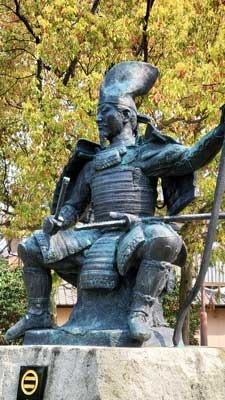
Born the third son of the military governor of Suruga and Tōtōmi provinces (now Shizuoka Prefecture), Imagawa Yoshimoto was known as the greatest daimyo (feudal lord) of the Tokaido, as well as for his accomplishments in governance and diplomacy. His marriage to the sister of Takeda Shingen of Kai Province (now Yamanashi Prefecture) enabled Yoshimoto to strengthen his alliance with Takeda, and the marriage of Yoshimoto's son to the daughter of Hōjō Ujiyasu of Sagami Province (now central and western Kanagawa Prefecture) brought peace to the eastern border of his domain in 1554, sealing a three-way alliance between former rivals.
Yoshimoto had sought to stem the encroaching influence of Nobunaga's father, Oda Nobuhide, in Mikawa Province (now eastern Aichi Prefecture), but was defeated at the Battle of Azukizaka in 1542. Several years later, Yoshimoto formed an alliance with Matsudaira Hirotada of western Mikawa, whose seat at Okazaki was threatened by Oda Nobuhide. (A condition of the alliance was that Matsudaira's 5-year-old heir, who would later become Tokugawa Ieyasu, be sent to Yoshimoto as a hostage.)
Following the assassination of Matsudaira in 1549, Mikawa Province was brought under Imagawa control, as Yoshimoto expanded his territory.
In June 1560, Imagawa Yoshimoto began his advance west, toward Nagoya Castle, with his 25,000-strong army, crossing from Mikawa into Owari Province, rapidly overcoming a number of Oda-held border fortresses.
He was 42 at the time of the Battle of Okehazama.
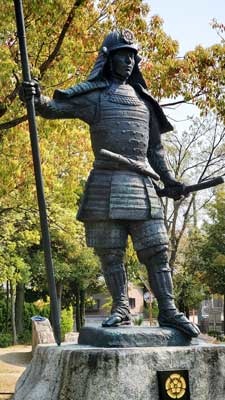 Oda Nobunaga (織田信長, 1534-1582)
Oda Nobunaga (織田信長, 1534-1582)
The second son of Oda Nobuhide, a deputy military governor of Owari Province, Nobunaga was known for bizarre and outrageous behavior in his youth, with little regard to his own status, earning him the epithet of "great fool of Owari". After the death of his father in 1551, a succession dispute erupted among the Oda clan, despite Nobunaga being his father's legitimate heir. Nobunaga suppressed those opposed to his rule, eliminating a rival branch in Kiyosu Castle in 1556. His younger brother, Nobuyuki, and his supporters were defeated in 1557, and by 1559, Nobunaga had unified Owari Province and overcome resistance to his rule.
When Imagawa Yoshimoto's forces overran the border fortesses at Washizu and Marune on their march west in June 1560, Nobunaga was advised to withdraw to Kiyosu Castle. Knowing that Kiyosu was unlikely to withstand a siege, Nobunaga instead chose to go on the offensive, despite only being able to send a force of 2,500 men, to counter the enemy's superior numbers.
Nobunaga himself led his army from Kiyosu to Atsuta Shrine, where they prayed for victory in the coming battle, and continued to the Zenshōji Fortress (near Narumi Station), close to the Imagawa lines.
He was 27 at the time of the Battle of Okehazama in 1560.
Historical sites connected to the Battle of Okehazama
Site of Sena Ujitoshi's Camp (瀬名氏俊陣地跡)
 Sena Ujitoshi, one of Imagawa Yoshimoto's retainers, led an advance party of around 200 men and set up camp here on 20 June. On 21 June, villagers were used to establish the main camp where Imagawa would rest during the day on 22 June.
Sena Ujitoshi, one of Imagawa Yoshimoto's retainers, led an advance party of around 200 men and set up camp here on 20 June. On 21 June, villagers were used to establish the main camp where Imagawa would rest during the day on 22 June.
After setting up the main camp, Sena headed for Odaka, and thus survived, later becoming a retainer for the Takeda clan.
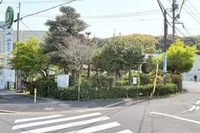 Sena Ujitoshi is said to have called the Imagawa generals together for a war council under a great pine tree which stood here at the time of the battle. The original tree fell during the Isewan Typhoon in 1959, and the current pine is the third.
Sena Ujitoshi is said to have called the Imagawa generals together for a war council under a great pine tree which stood here at the time of the battle. The original tree fell during the Isewan Typhoon in 1959, and the current pine is the third.
Legend has it that on 22 June, a white-robed apparition of Imagawa Yoshimoto appears here astride a white horse and gallops around the nearby Oike Pond. A fishmonger from Kariya said to have seen the specter in the Edo period was warned by Imagawa's ghost not to speak to others of the encounter. Unable to keep the secret, the fishmonger suddenly broke out in a fever and soon died.
Okehazama Shinmei Shrine (桶狭間神明社)
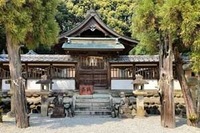 Okehazama village is said to have been established by former soldiers who had fled the Southern Court in the 1340s. The date of the founding of Shinmei Shrine is unclear, but it existed as a center of worship before 1600. A sake barrel said to have been offered by Sena Ujitoshi with prayers for victory at the time of the Battle of Okehazama is kept here as one of the shrine treasures.
Okehazama village is said to have been established by former soldiers who had fled the Southern Court in the 1340s. The date of the founding of Shinmei Shrine is unclear, but it existed as a center of worship before 1600. A sake barrel said to have been offered by Sena Ujitoshi with prayers for victory at the time of the Battle of Okehazama is kept here as one of the shrine treasures.
Okehazama-yama (Mount Okehazama) (おけはざま山)
 Imagawa Yoshimoto's main camp is said to have been situated in what is now a residential area on a hill to the east of the Okehazama Kosenjo Park. With ample sunlight, fresh water and grass, the mountainside is also thought to have been chosen for the commanding view it would have offered over the advance guard encamped at Takaneyama, Makuyama and Makiyama. The lack of roads and steep incline around the hilltop, at an elevation of 64.7m, would have made it inaccessible to riders on horseback.
Imagawa Yoshimoto's main camp is said to have been situated in what is now a residential area on a hill to the east of the Okehazama Kosenjo Park. With ample sunlight, fresh water and grass, the mountainside is also thought to have been chosen for the commanding view it would have offered over the advance guard encamped at Takaneyama, Makuyama and Makiyama. The lack of roads and steep incline around the hilltop, at an elevation of 64.7m, would have made it inaccessible to riders on horseback.
 Oda Nobunaga had many banners raised at Zenshōji Fort (about 800m east-northeast of Narumi Station) to convince the enemy that he was headquartered there, while Nobunaga himself led a force from Nakajima Fort (about 400m east-southeast of Narumi Station) along the Ōgigawa River, cutting across and into the hills north of the current location of Arimatsu Station before arriving at this valley, where they hid amid a violent storm as they waited for an opportunity to strike.
Oda Nobunaga had many banners raised at Zenshōji Fort (about 800m east-northeast of Narumi Station) to convince the enemy that he was headquartered there, while Nobunaga himself led a force from Nakajima Fort (about 400m east-southeast of Narumi Station) along the Ōgigawa River, cutting across and into the hills north of the current location of Arimatsu Station before arriving at this valley, where they hid amid a violent storm as they waited for an opportunity to strike.
The site is now on the grounds of Ohkagakuen University Nagoya College; permission is required to enter.
Okehazama Kosenjo Park (桶狭間古戦場公園)

The central site of the Battle of Okehazama, where Imagawa Yoshimoto is said to have met his end. On Okehazama-yama, some 300 Imagawa troops fought, with their commander at the center, under Nobunaga's attack, but were soon driven down the western hillside to the edge of the rice fields, and Imagawa was cornered and beheaded by Nobunaga vassals Hattori Koheita and Mori Shinsuke. In 2010, 450 years after the battle, the site was developed into the Okehazama Kosenjo (historic battlefield) Park, a diorama simulating the topography of the wider area at the time of the battle, with positions of castles, forts and the routes of the respective armies, and bronze statues of Oda Nobunaga and Imagawa Yoshimoto as the centrepiece. Also within the park is a stone grave marker bearing the inscription, "Sunkō boketsu" (駿公墓碣), or "grave of the great lord / lord of Suruga" (i.e. Imagawa), and every year a memorial service is held for those who fell during the battle. As the main site of the Battle of Okehazama, the park is visited by history aficionados and many other people from all over Japan.
 A Jodo-shu Buddhist temple of the Seizan branch, established in 1538. Following the Battle of Okehazama, Nobunaga is said to have carried out the identification of the heads of Imagawa Yoshimoto and his soldiers within the temple grounds.
A Jodo-shu Buddhist temple of the Seizan branch, established in 1538. Following the Battle of Okehazama, Nobunaga is said to have carried out the identification of the heads of Imagawa Yoshimoto and his soldiers within the temple grounds.
Yoshimoto's attendant, Rin Ami (林阿弥), took part in the verification of the heads, and was allowed to return home. He later visited the temple, presenting a statue of the Amitabha Buddha as a memorial to his fallen master. Wooden figures of Imagawa Yoshimoto and Matsui Munenobu are also enshrined here, and there are other artifacts and sites connected with the battle.
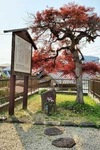 Shortly after the defeat of Imagawa Yoshimoto, Oda Nobunaga gathered his troops at Kamagatani, where they declared their victory. He then ordered the villagers to dig seven evenly-spaced holes along the foot of the hill and bury the great number of dead. (Around 3,500 Imagawa and Oda soldiers are said to have died during the battle, and the same number of candles are lit in a memorial ritual during the Battlefield Festival.)
Shortly after the defeat of Imagawa Yoshimoto, Oda Nobunaga gathered his troops at Kamagatani, where they declared their victory. He then ordered the villagers to dig seven evenly-spaced holes along the foot of the hill and bury the great number of dead. (Around 3,500 Imagawa and Oda soldiers are said to have died during the battle, and the same number of candles are lit in a memorial ritual during the Battlefield Festival.)
Known to locals as Nanatsu-zuka ("seven tombs") or Ishi-zuka (石塚 / "stone tombs"), two of the seven gravesites retained their original form until recently, and it is said that a curse took the lives of some who destroyed the graves. In 1989, rezoning of the area saw the development of the site and the erection of a memorial stone on a corner of the last remaining gravesite.
Map of Battle of Okehazama Historical Sites (PDF)
More information
- NPO Okehazama Kosenjo Preservation Society (NPO法人桶狭間古戦場保存会)
Website: https://okehazama.net/ (Japanese with some English content) - Nobunaga's Victory Road - The Battle of Okehazama (Nagoya Convention & Visitors Bureau)
Website: https://nobunaga-kouro.nagoya/en/index.html




